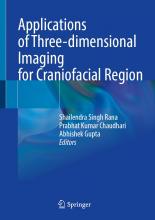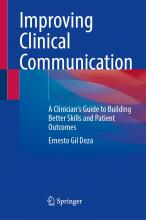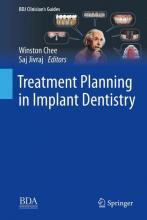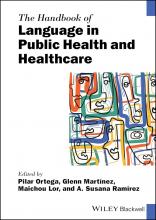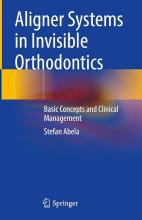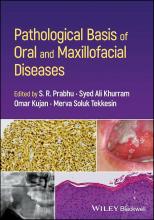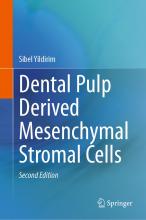New Books - January 2025
New eBooks
Applications of Three-dimensional Imaging for Craniofacial Region / edited by Shailendra Singh Rana, Prabhat Kumar Chaudhari, Abhishek Gupta
Springer 2024
"The book provides sound knowledge of 3D imaging of dentofacial craniofacial region. It guides the students and faculty for understanding the dentofacial craniofacial region in depth. It incorporates the latest techniques, frameworks and technologies in the imaging area of oral health. The book emphasizes on the dentofacial and craniofacial region and thus fills the gap in the medical imaging literature.
The development in this book is not only on the imaging techniques but also emphasis will be on the three-dimensional (3D) frameworks to deal the patients for their diagnosis and treatment planning. The chapters of this book are designed in such a way that the readers may get the complete package of the exploration of the imaging clinical applications of craniofacial areas. This book will be helpful not only for the students and faculty but also for the researchers working in the relevant areas.
This book will provide easy, simple way but the most authentic material to learn the craniofacial region imaging. In this manual we will incorporates authentic, internationally accepted terms and definition. To make it interesting and simple, our approach is to incorporate the material in systematic manner in a simple and easy way by incorporating maximum illustrations and flowcharts. This book provides sound knowledge of various advanced technologies for dentist imaging. This book will highlights the importance and explore the current research in the dentofacial and craniofacial areas." From publisher's website.
Concepts of Tissue‐Biomaterial Interactions: Fundamentals and New Directions / by Rena Bizios, Marissa Wechsler
John Wiley & Sons 2024
"Biomedical engineering is an established interdisciplinary research and training area, combining various aspects of physiology, biology, materials science and engineering. Biomedical engineering programs and courses are integral parts of pertinent curricula, generating an urgent need for textbooks which can introduce this fundamental subject to new generations of students, researchers and practicing professionals.
The textbook Concepts of Tissue-Biomaterial Interactions meets this need with an introduction to the subject. Beginning with various, key, fundamental concepts of cellular biology and the physiology of tissue wound healing (required to understand interactions of tissues and implants) it offers essential information and insight regarding the design of successful biomaterial implants. Concluding with a look at the current forefront and future of the field, it is an indispensable introduction for fundamental and cutting-edge aspects of biomedical engineering applications.
Concepts of Tissue-Biomaterial Interactions readers will also find:
- Introduction to biological aspects such as cell-extracellular matrix interactions and cell-substrate interactions
- Details regarding various aspects of the process of normal tissue wound healing
- Current knowledge of tissue wound healing in the presence of implants
- Examples of pathological complications, including infection
- Design criteria for biocompatible implants
- The process of obtaining regulatory approval of new biomaterials and implantable medical devices by pertinent regulatory agencies
- Implant biomaterial and medical devices: past, present, and future
Concepts of Tissue-Biomaterial Interactions is recommended for advanced undergraduate and for graduate students interested in biomedical engineering, biomaterials, tissue engineering, and implantable biomaterials/medical devices, as well as a reference for practicing biomedical engineering professionals." From publisher's website.
Improving Clinical Communication: A Clinician's Guide to Building Better Skills and Patient Outcomes / by Ernesto Gil Deza
Springer 2024
"This is a book about medical communication. Communication is a skill, as such it is learnable and can be refined. Between what we learn in college and clinical practice there is a gap regarding communication with patients and their families that many health professionals want to fill. Thus, the goal of this book is to encourage readers to develop their communication skills in patient care.
Chapters cover the possible therapeutic origin of the human word, the placebo effect of the medical word, the distinction between information and communication, and the importance of empathy while communicating with patients. An overview of the medical words throughout history up to our current practice is presented. In addition, the content helps to develop a strategy for nonverbal communication and to analyse the impact of empathy on communication and patient satisfaction. Current topics such as special needs for LGBTQ patient care, telehealth and virtual communication are also featured in this book.
Knowing how to communicate is healthy not only for the patient but also for the doctor. Therefore, the prevention of medical burnout through adequate communication, both in routine practice, and with patients with special needs, as well as in telemedicine is also discussed.
Finally, the author addresses a personal and non-transferable task: each individual must build their own toolbox for communication - the stories, the anecdotes, the metaphors, the silences with which each of the readers will use to communicate with their patients.
The aim of this book is to bridge a gap between the graduate and postgraduate training for dealing with information and problems in communicating during clinical practice. Since it is never too late to acquire or improve our communication skills, this work will be a useful and valuable resource for any health professional interested in the subject." From publisher's website.
Treatment Planning In Implant Dentistry / edited by Winston Chee, Saj Jivraj
Springer 2024
"This book outlines a comprehensive interdisciplinary practice philosophy designed for developing the foundation of optimal diagnosis and treatment planning in implant dentistry. Each chapter will have a comprehensive literature review followed by diagnosis, treatment planning and comprehensive patient case presentations. The goal of modern implant dentistry is no longer represented solely by successful osseointegration. In order to claim success, the definitive restorations must be surrounded by a soft and hard tissue environment in harmony with the existing dentition. This book focuses on analogue and digital workflows from single tooth to full mouth. It discusses the approach of interdisciplinary therapy which involves the combination of knowledge, skills, and experience of all the disciplines of dentistry. Information on the rationale for dental implants and surgical guidelines is provided as well as on the biomechanics of occlusion and the medical evaluation of the implant patient. Subsequent chapters cover treatment planning in the aesthetic zone, impression techniques and scanning, the role of orthodontics in implant dentistry, and screw and cemented restorations. Implant maintenance and failures and complications are discussed in the final part of this book, which is a valuable resource for a wide range of practitioners." From publisher's website.
The Handbook of Language in Public Health and Healthcare / edited by Pilar Ortega, Glenn Martínez, Maichou Lor, A. Susana Ramírez
John Wiley & Sons 2024
"With a joint linguistic and medical perspective, The Handbook of Language in Public Health and Healthcare explores innovative approaches for improving clinical education, clinician-patient communication, assessment, and mass communication. Contributions by a diverse panel of experts address a wide range of key topics, including language concordance in clinical care, medical interpreting, the role of language as a social determinant of health, reaching linguistically diverse audiences during public health crises, assessing clinician language skills, and more.
Organized into five parts, the Handbook covers the theory, history, and context of linguistics, language interpretation and translation, language concordance, medical language education pedagogy, and mass communication of health information with linguistically diverse populations. Throughout the text, detailed chapters present solutions and strategies with the potential to improve the health and healthcare of linguistically diverse populations worldwide.
In an increasingly multilingual, global society, language has become a critical area of interest for advancing public health and healthcare. The Handbook of Language in Public Health and Healthcare:
- Helps professionals integrate language-appropriate communication in healthcare settings
- Addresses clinician-patient communication, assessment, research, and mass public health communication
- Offers key theoretical insights that inform the intersection of language, public health, and healthcare
- Highlights how various approaches in the field of linguistics have enriched public health and healthcare practices
The Handbook of Language in Public Health and Healthcare is essential reading for undergraduate, postgraduate, and professional students of applied linguistics, health communication, and medicine. It is also an invaluable reference for language educators, clinicians, medical educators, linguists, health policy experts, and researchers." From publisher's website.
Aligner Systems in Invisible Orthodontics: Basic Concepts and Clinical Management / by Stefan Abela
Springer 2024
"This richly illustrated book describes the processes, techniques and biomechanics involved in providing aligner treatment for different types of malocclusions. It opens with an overview of the material characteristics and the basic concepts of aligner therapy including topics like biocompatibility and intraoral deterioration. The main part of the book is dedicated to the various types of aligners, the methods used in their application and the practical aspects of delivery. It is structured based on the type of malocclusion being managed giving the reader a systematic pattern and a practical way of progressing through the book. The book closes with a discussion of the scientific data available.
This comprehensive step-by-step guide on aligner systems is a must have for both dental undergraduate and postgraduate dental students as well as for fully practising clinicians who want to deepen their knowledge in this innovative technique." From publisher's website.
Dictionary of Toxicology / by AB Pant
Springer 2024
"This dictionary of toxicology provides curated and authentic information on the terminologies used with their description as per modern toxicology and associated declines. It aims to have a collection of over 3500 terminologies with their basic information and roles with relevance in toxicology and associated disciplines in alphabetical order. This book has a flow of information in alphabetical order starting from word A to Z. The contents cover all the possible facets of contemporary. It is an unparalleled reservoir of information with a practical understanding of the subject for undergraduates, post-graduate, doctorate and post-doctorate, researchers of toxicology, medical and dental sciences, veterinary sciences, pharmacy sciences, life sciences, forensic sciences, etc. Besides this, target readers would also be personnel working in academia, pharma industries, contract research organizations involved in regulatory studies, regulatory agencies and implementing agencies, and people having an interest in toxicological sciences." From publisher's website.
Pathological Basis of Oral and Maxillofacial Diseases / edited by S. R. Prabhu, Syed Ali Khurram, Omar Kujan, Merva Soluk Tekkesin
John Wiley & Sons 2025
"Pathological Basis of Oral and Maxillofacial Diseases presents the basic principles involved in disease mechanisms in an easy-to-understand way. By integrating recent advances in molecular, immunologic, and genetic understanding of oral disease, the book helps readers enhance their knowledge and its application in a clinical setting.
This book is divided into nine sections, covering key topics such as inflammation, genetic diseases, and neoplasia, with contributions from over 50 international authors. Diagrams, clinical, radiographic, and histopathology images and tables supplement the text, and the editors have ensured a consistent approach throughout.
Topics covered in Pathological Basis of Oral and Maxillofacial Diseases include:
- The influences of nutrition and the environment
- Cellular structure and function, causes and mechanisms of cellular pathology.
- Immunity and host defence mechanisms, immune dysfunctions affecting the oro-facial complex.
- Inflammation and inflammatory diseases of the oro-facial complex
- Human microbiome, with reference to dysbiosis in dental caries and periodontal diseases
- Oral manifestations of systemic diseases and the oral-systemic link and its impact on general and oral health
- Oral potentially malignant and malignant disorders that are a major threat to global public health.
Bridging the gap in dental training programs from basic medical science in the initial years to clinical practice, Pathological Basis of Oral and Maxillofacial Diseases is an essential reference for dental students, trainees and practitioners seeking to grasp the pathological basis of disease and apply that knowledge to the oral and maxillofacial regions." From publisher's website.
Advanced Strategies for Tooth Extraction in Dentistry: Beyond Basics / by Seong-Gon Kim, Ji-Hyeon Oh, Dae-Seok Hwang
Springer 2024
"The book aims to provide comprehensive insights and techniques to dental students and practicing dentists seeking to expand their skills in tooth extraction. Building upon the foundational knowledge acquired during dental education, this book delves into the intricacies of advanced tooth extraction strategies. It covers a wide range of topics, including complex extractions, impacted teeth, surgical techniques, management of complications, and specialized cases. The book takes a practical approach, combining evidence-based principles with clinical expertise to equip readers with the necessary tools to tackle challenging extraction cases confidently.
The purpose of this book is to bridge the gap between basic tooth extraction skills and the demands of real-world clinical practice. It recognizes that dentists need to continually enhance their abilities to handle more complex cases and overcome potential complications. By presenting advanced strategies and insights, the book aims to empower readers to refine their decision-making skills, improve surgical techniques, and optimize patient outcomes. Through clear explanations, detailed illustrations, and case examples, the book will serve as a valuable resource for dentists seeking to expand their expertise in tooth extraction. It strives to elevate the reader's confidence, competence, and proficiency in handling a wide range of extraction scenarios, ultimately enhancing the quality of dental care provided to patients." From publisher's website.
Dental Pulp Derived Mesenchymal Stromal Cells / by Sibel Yildirim
Springer 2024
"This book presents an evaluation of stem cells from human dental pulp as a reliable stem cell source for cell-based therapy to stimulate tissue regeneration. In this thoroughly updated and expanded second edition, the author covers mesenchymal stem cell (MSC) biology, various sources of MSCs, and the therapeutic potential of MSCs. Tooth regeneration, dental pulp-derived MSC, and the therapeutic potential of dental pulp derived stem cells is also covered. This is an essential resource for students, faculty, and researchers in academia and industry working on dental pulp stem cells." From publisher's website.

